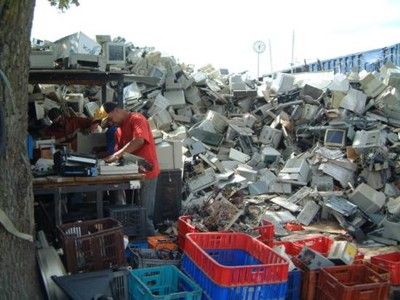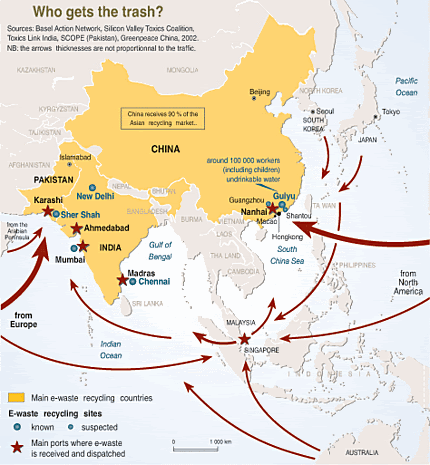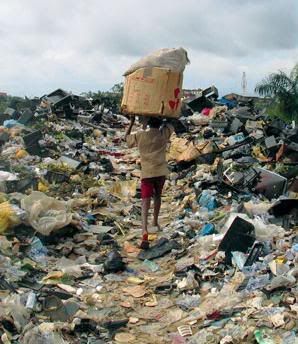(cross-posted at Deny My Freedom and Daily Kos)

One of the good things about my job over the summer is that I get exposed to just about everything going on in the world. Today, I was reviewing a company in the business of recycling electronics – and it opened my eyes as to just how big this problem really is. One reason the issue doesn’t get much visibility is because we never see much of it to begin with.
For years, developed countries have been exporting tons of electronic waste to China for inexpensive, labor-intensive recycling and disposal. Since 2000, it’s been illegal to import electronic waste into China for this kind of environmentally unsound recycling. But tons of debris are smuggled in with legitimate imports, corruption is common among local officials, and China’s appetite for scrap is so enormous that the shipments just keep on coming.
In Taizhou’s outdoor workshops, people bang apart the computers and toss bits of metal into brick furnaces that look like chimneys. Split open, the electronics release a stew of toxic materials — among them beryllium, cadmium, lead, mercury and flame retardants — that can accumulate in human blood and disrupt the body’s hormonal balance. Exposed to heat or allowed to degrade, electronics’ plastics can break down into organic pollutants that cause a host of health problems, including cancer. Wearing no protective clothing, workers roast circuit boards in big, uncovered woklike pans to melt plastics and collect valuable metals. Other workers sluice open basins of acid over semiconductors to remove their gold, tossing the waste into nearby streams. Typical wages for this work are about $2 to $4 a day.
Electronic waste, or e-waste, is fast becoming an ecological nightmare in this era of rapid technological growth.
It’s difficult to find numbers on a problem that has largely been swept under the rug, as the Salon article above mentions. In 2000, the U.S. created over 2.1 million tons of e-waste, a figure that has surely become higher with our technological advances in recent years. All sorts of devices – personal computer, cell phones, televisions, refrigerators – you name it, and if it’s an electronic device, it probably counts as e-waste. These products contain several harmful substances that can be severely harmful or fatal to humans if we are exposed to it for extended periods of time. If you still have one of those big, box-like CRT monitors, the glass in the screen is composed of 25% lead – necessary to block the radiation from the cathode ray tube that brings your monitor to life. Cadmium comes in semiconductors which are omnipresent within computers and cell phones. Mercury is present in many everyday-life objects. Much of what we use today is a danger to the environment if not disposed of safely.
The dangerous toxins within many of our electronics is the reason why these materials need to be recycled, not simply thrown away in a landfill. The leaking of these chemicals has a devastating effect on the surrounding environment:
Poisonous waste creeps into skin and lungs and seeps into the land and water: Guiyu’s soil contains 200 times the level of lead considered hazardous; the drinking water is 2,400 times over the World Health Authority (WHO) lead threshold. “We found a cyber-age nightmare,” says Puckett. “They call this recycling, but it is really dumping by another name.”
In 2000, 4.6 million tons of e-waste was disposed of in landfills in the U.S. That’s more than 2 times the amount of e-waste that was produced in the year. This high rate of turnover is certainly worrisome, and many of the other disposal methods are not better. Incineration releases dangerous chemicals into the air, and reusing the products merely prolongs the dumping of the electronics. One of the biggest problems, though, is that much of the e-waste that is produced is exported to foreign countries, particularly China, India, along with the African continent. This does nothing to solve the problem; instead, it makes the developing world our dumping grounds. Despite it being in violation of international law and China’s ban on the practice in 2000, it continues to this day due to corruption in the developing world and of lax enforcement policy in the developed world.

From the Salon article:
The EPA estimates that only about 10 percent of all obsolete consumer electronics are recycled. The rest are stored somewhere, passed on to second users, or simply tossed in the trash.
Your end result looks something like this. Here’s a picture from an e-waste dump in Africa.

Photographs taken by BAN in Lagos show scrapped electronics lying in wetlands, along roadsides, being examined by curious children and burning in uncontained landfills. Seared, broken monitors and CPUs are nestled in weeds, serving as perches for lizards, chickens and goats. One mound of computer junk towers at least 6 feet high. Puckett found identification tags showing that some of the junked equipment originally belonged to the U.S. Army Corps of Engineers, the Illinois Department of Human Services, the Kansas Department of Aging, the State of Massachusetts, the Michigan Department of Natural Resources, the City of Houston, school districts, hospitals, banks and numerous businesses, including IBM and Intel.
To face this problem, the Basel Convention was convened to discuss the problem. Its stated goal was to reduce movement of hazardous materials between countries, particularly the one-sided movement from industrialized nations to developing ones. However, it should figure that, just like with the Kyoto protocols, the United States is the only industrialized nation to have not ratified the Basel Convention’s treaties (the only other countries to have signed but not ratified it are Afghanistan and Haiti). Once again, our country has continued to show a lack of leadership on environmental issues. On the other hand, the European Union has instituted WEEE, short for Waste Electrical and Electronic Equipment. It specifies that manufacturers must accept returned items and dispose of them properly, as well as manufacturing electronics that removes many of the toxic elements that compose many of our technologies today.
Although Europe still must deal with the problem of the illegal exporting of such materials, they have made more progress than we have on the issue. Observe how our government disposes of its used electronics:
Much of the federal government’s used but usable computer equipment (including cellphones) is placed with another government agency or donated to a school or community nonprofit (usually chosen and vetted by an individual agency office). The rest (the exact numbers are not known) goes to the General Services Administration — the agency that deals with the procurement, use and disposal of government property — for public auction. State governments work similarly, usually through state surplus property offices or equivalent programs. No one I consulted had any estimate of how many computers state and local governments discard annually. What was clear is that the ultimate fate of significant quantities of government electronics is poorly documented.
[…]
The GSA keeps records of who’s bought equipment, but does not track what happens to equipment that’s been sold, nor does it ask buyers why they’re purchasing the electronics. “Why would we?” asks a GSA staffer in Boston. The result is that at both the state and federal level, large quantities of electronics are purchased by brokers, auctioneers and individual dealers who often sell the equipment for export.
In effect, America has continued to enable the exports of e-waste. Without any sort of accountability, our used computers from our school systems can end up in dumps halfway around the world (the Salon article details this in more depth).
However, states have begun to take action while the federal government ignores the problem. Four states – California, Maine, Maryland, and Washington – have passed legislation that promotes the recycling of e-waste, and several other states are currently considering bills that will confront the problem of disposing of e-waste. Efforts in Congress have been stalled by the GOP-controlled body, despite the bipartisan nature of the legislators pushing for it. In the House, Democrat Mike Thompson of California has been in the lead, along with Louise Slaughter (D-NY), Mary Bono (R-CA), and the now-disgraced ex-congressman Duke Cunningham (R-CA). In the Senate, Senators Ron Wyden (D-OR) and Jim Talent (R-MO) have introduced a comprehensive plan to create a national recycling program, but there has been no further movement on the issue.
The current focus of environmental policy is focused on global warming, in large thanks to Al Gore’s An Inconvenient Truth. However, our country needs to address another truth, one that will become tangibly more visible as we develop new technologies: e-waste is a growing menace, and if left unchecked and unregulated, it could cause irreparable harm to the environment around us. Just as Gore says about alternative energy, instituting a recycling policy will not cost corporations more – in fact, it is a very profitable business. The secondary products produced from recycling, such as glass, can be used easily by other companies in their products.
Political will is indeed a renewable resource. Let’s make sure that our representatives find it when it comes to this issue.




